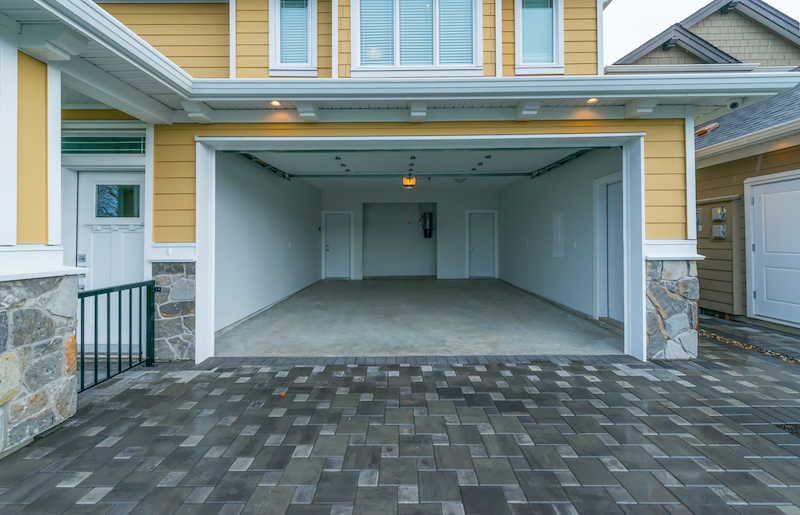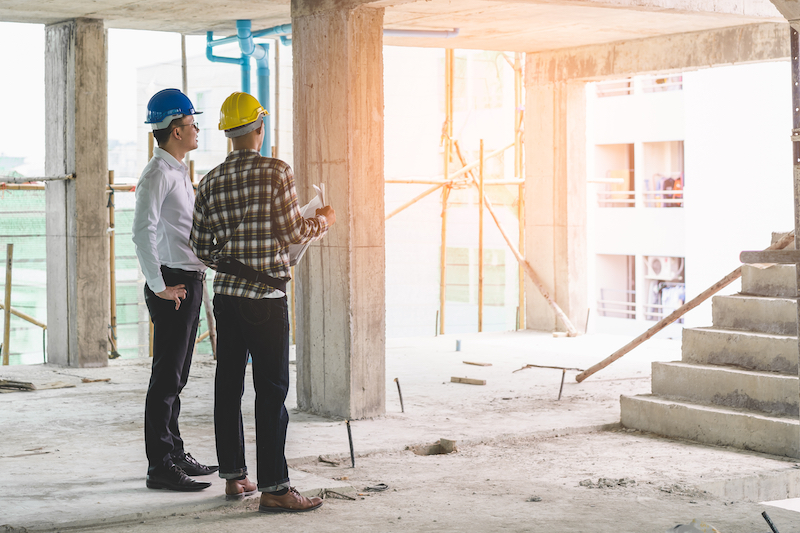Converting your garage can be an excellent way to add extra living space and value to your home. In this blog post, we’ll explore various aspects of garage conversions, from costs and ROI to local regulations and permits.
We’ll also discuss maximizing space utilization, flooring options, door insulation, reversibility considerations, alternative options for extra living space, HVAC systems in converted garages, and even renting out your newly converted garage on Airbnb. So let’s dive into the world of garage conversion ideas!
Assessing the Costs and Benefits of Garage Conversion
Are you considering a garage conversion project? Converting your garage into a rental space can be a lucrative decision, with costs typically ranging between $5,719 and $24,316. However, before embarking on this endeavor, it’s essential to research local regulations and permits required for converting garages into living spaces.
Table of Contents:
- DIY vs Professional Contractors
- Questions to Ask Potential Contractors
- Ensuring Compliance with Building Codes
- Installing Wall-Controlled Light Switches and Changing Wall Outlets
- Preparing Your Garage Space for Rental Purposes
- Long-term Implications of Garage Conversions
- Expanding Your Home with Additions or Structural Changes
- HVAC Considerations During Garage Conversion
- FAQs in Relation to Converting Your Garage
- Conclusion
DIY vs Professional Contractors
When planning a garage conversion project, you have two options: DIY or hiring professionals. While attempting a DIY garage conversion may seem cost-effective, it can be taxing and complex for those without experience. On the other hand, hiring a professional contractor ensures quality workmanship and adherence to building codes.
Pros and Cons of DIY Conversions versus Hiring Professional Contractors
When weighing the benefits of a DIY garage conversion against those of hiring professional contractors, consider factors such as time commitment, the skill level required for specific tasks like electrical work or plumbing installation, and potential risks associated with each option, such as safety hazards.
Anecdote: One homeowner who successfully converted their own garage may have saved thousands of dollars by doing so. However, another homeowner who hired professionals had peace of mind knowing their project was completed safely and up to code, with superior workmanship.
Tax Credits Available for Garage Conversion Projects
Tax credits can help alleviate some of the financial burden when converting your garage into a living space. For example, energy-efficient upgrades such as insulation improvements or installing new windows may qualify for federal tax incentives like the Nonbusiness Energy Property Tax Credit.
Enquire with your local government about any extra incentives or plans that could be beneficial in covering the costs of transforming your garage into a living space.
Comparing Prices from Multiple Vendors to Get the Best Deal
To ensure you’re getting the most value for your investment in a garage conversion project, request quotes from several contractors or suppliers. This will allow you to compare pricing options and make an informed decision based on quality workmanship at competitive rates.
Understanding Local Regulations Regarding Off-Street Parking Requirements
Before starting any construction work, familiarize yourself with zoning laws that may affect your plans. Some municipalities have strict rules about maintaining off-street parking when converting garages into living spaces. Violating these codes could result in fines or even reversal of completed work.
Whether you have a single-car garage or a two-car garage, detached or attached, converting it into a living space can add square footage and value to your home. Transforming a garage into an extra bedroom, home office, or even a rental unit can be an effective way to add value and square footage to your house.
At MGC Decks, we specialize in home additions and renovations, including garage conversions. Contact us today to learn more about how we can help you transform your garage into a functional and stylish living space.
Assess the costs and benefits of converting your garage into a living space, with prices ranging from $5,719 to $24,316. Consider DIY versus hiring professional contractors for quality workmanship and adherence to building codes. Research local regulations regarding off-street parking requirements before starting any construction work.
Questions to Ask Potential Contractors
When hiring professional contractors, it’s essential to ask the right questions. Inquire about their experience with similar projects, licensing and insurance information, references from past clients, and a detailed estimate of the garage conversion costs.
Ensuring Compliance with Building Codes
When converting your garage, it’s crucial to comply with building code requirements. These regulations ensure the safety and comfort of your new living space while avoiding potential fines or penalties from local authorities.
For example, adding enough windows for proper ventilation and natural light can make a significant difference in the overall appeal of your converted garage. Additionally, maintaining minimum ceiling height standards (7 1/2 feet) ensures that occupants have adequate headroom.
Proper Insulation Techniques for Temperature Control within New Living Spaces
Proper insulation plays an essential role in temperature control and energy efficiency when converting your garage. It not only keeps the space warm during winter months but also helps maintain cooler temperatures during hot summer days.
Researching various insulation materials, their R-values, and installation methods will help you choose the best option for your specific project needs.
Adding Interior or Exterior Doors During the Conversion Process
Incorporating interior or exterior doors into your garage conversion design can enhance accessibility between spaces while providing additional privacy when needed. This addition may require structural modifications to accommodate door frames properly; therefore, consulting with professionals is highly recommended before making any changes to existing walls.
For a more aesthetically pleasing transition between interior and exterior living areas, consider replacing the existing garage doors with French or sliding glass doors.
Installing Wall-Controlled Light Switches and Changing Wall Outlets
Updating electrical systems is another essential aspect of garage conversions. Installing wall-controlled light switches ensures that occupants can easily control the lighting within the space without relying on pull chains or remote controls.
Additionally, changing wall outlets according to spacing guidelines allows for convenient access to power sources while adhering to safety standards. Consulting with a licensed electrician will help you determine the best placement for these updates based on your specific layout and needs.
Converting your garage into a living space requires compliance with building codes, such as adding enough windows for proper ventilation and maintaining minimum ceiling height standards. Proper insulation techniques are also important to control temperature and energy efficiency, while incorporating interior or exterior doors can enhance accessibility between spaces. Updating electrical systems by installing wall-controlled light switches and changing wall outlets is crucial for convenience and safety.
Preparing Your Garage Space for Rental Purposes
Before you can start renting out your converted garage, it’s essential to elevate floor coverings above concrete floors and insulate any existing doors properly. This ensures that the space is comfortable and functional for future occupants or homeowners. You might also want to consider listing your newly converted space on platforms like Airbnb as a way of generating extra income from this new living area.
Steps Involved in Preparing Your Converted Space for Renting Out on Airbnb or Other Platforms
To prepare your garage conversion for rental purposes, first, ensure that all necessary permits have been obtained and building codes are met. Furnish the converted space with necessities like beds, seating areas, kitchen appliances (if necessary), and other amenities to make your guests feel comfortable. Create an appealing online listing by taking high-quality photos of the interior and exterior spaces while highlighting unique features or benefits of staying in your rental property. Finally, set competitive pricing based on comparable listings in your area.
Tips on How to Make Your Rental Property Appealing to Prospective Tenants
To attract potential tenants to your converted garage rental property, focus on creating a clean, inviting atmosphere with modern design elements. Consider adding personal touches such as artwork or plants that reflect local culture or interests. In addition to providing basic necessities like linens and toiletries, offer extras like Wi-Fi access, streaming services, or even a welcome basket with snacks and local information. These small gestures can make a big difference in setting your rental apart from others on the market, and past tenants will be more likely to leave positive reviews, thus leading to a higher demand for your converted garage.
Long-term Implications of Garage Conversions
When considering a garage conversion, it is prudent to consider the potential effects on your property value over time. In urban settings, having access to both indoor and outdoor storage facilities can be highly desirable among prospective buyers.
Property values may be impacted differently depending on location and market trends. Make sure you research how conversions have affected homes in your area before making any decisions.

How Garage Conversions Can Impact Property Values in Different Locations
In some cases, converting a garage into a living space can increase the overall value of your home by adding extra square footage. However, this isn’t always true for every location or housing market.
Talk to local real estate pros or appraisers who have experience with comparable conversions in your area to get an exact idea of how the change might affect your home’s worth.
Ensuring Reversibility of the Conversion Process for Future Needs
Another aspect to consider is whether the garage conversion process is reversible. If you decide to sell your home later down the line and potential buyers prefer traditional garages over converted spaces, being able to reverse the changes could make all the difference when selling.
Work closely with contractors during planning stages so that they understand reversibility as one of your priorities while still maintaining high-quality workmanship throughout construction phases.
Expanding Your Home with Additions or Structural Changes
As a homeowner, if you need more living space but are hesitant about permanently altering your garages, building an addition to your existing home or expanding the size of the current structure is a viable alternative, while a basement remodel can also go a long way. This way, you can maintain valuable storage areas while still gaining extra square footage for various uses such as offices, gyms, or playrooms.
Weighing the Pros and Cons of Garage Conversions Versus Home Additions
Before deciding on a garage conversion or home addition, it’s essential to weigh the pros and cons of each option. Garage conversions tend to be less expensive than additions but may require sacrificing valuable storage space. On the other hand, home additions offer increased flexibility in design and layout but often come at a higher cost.
Tips on Choosing Between Expanding Your Current Structure or Adding New Rooms
To make an informed decision between expanding your current structure versus adding new rooms, consider factors like budget constraints, available outdoor space for construction projects, the potential return on investment (ROI) from property value increases, and how the changes will impact your family’s lifestyle. Consulting with a specialist contractor can be beneficial in determining which choice is the most suitable for your requirements.
HVAC Considerations During Garage Conversion
When transforming a garage into an enjoyable living area, taking care of the needs for heating, ventilation, and air conditioning (HVAC) is critical. A well-designed HVAC system ensures that the converted area maintains optimal temperature and humidity levels for its occupants.
To achieve this goal, you may need to update your existing HVAC system or invest in separate standalone equipment specifically designed for the new environment. The choice depends on factors such as the current capacity and energy efficiency of your home’s central system.
Updating Existing HVAC Systems to Meet New Demands from Converted Spaces
If your current HVAC setup has enough capacity to handle additional square footage from the garage conversion, consider extending ductwork or adding extra vents. This solution allows seamless integration with minimal disruption to other parts of your home. However, before making any changes, consult an experienced professional who can assess whether upgrading is feasible without compromising overall performance or causing excessive strain on existing components.
Choosing Energy-Efficient Heating and Cooling Options for Your Rental Property
In cases where updating isn’t practical or cost-effective due to insufficient capacity or outdated systems, installing independent heating and cooling units like ductless mini-split heat pumps might be a better option. These systems are energy-efficient, easy to install, and provide targeted temperature control for the converted space.
When selecting a standalone HVAC solution, prioritize energy efficiency ratings such as Energy Star certification. This not only helps reduce utility bills but also demonstrates your commitment to sustainable living practices – an attractive feature for potential renters. An investment in energy-efficient air conditioning systems, programmable thermostats, and proper insulation techniques when planning your garage conversion project will go a long way in reducing utility bills as well.
Expanding your home with additions or structural changes is a viable alternative to permanently altering your garages. Before deciding on a garage conversion or a home addition, weigh the pros and cons of each option, considering factors like budget constraints, available outdoor space for construction projects, potential return on investment (ROI) from property value increases, and how the changes will impact your family’s lifestyle.
FAQs in Relation to Converting Your Garage
Is it a Good Idea to Convert Your Garage?
It’s typically more cost-effective than building an addition, and it can increase the value of your home when done properly. However, consider local regulations, permits, and potential impact on property value before proceeding.
What to Consider Before Converting a Garage?
- Local regulations and permit requirements
- Potential impact on property value
- Flooring options and door insulation
- HVAC system updates or additions
- Maximizing space utilization
- Reversibility and long-term implications
Does Garage Conversion Devalue Your House?
A well-executed garage conversion may increase the overall value of your home by adding functional living space. However, in some cases where parking is at a premium or buyers expect garages as standard features in homes, removing this amenity could negatively affect resale values. Research local market trends before making any decisions.
Where Do I Start When Converting My Garage?
- Analyze local regulations and obtain necessary permits
- Contact multiple contractors for quotes
- Determine flooring options and insulation needs
- Create design plans maximizing available space
- Evaluate HVAC system updates or additions required
If you’re interested in making additions to your home, garage conversions are a great option to consider. Converted garages can be used for a variety of purposes, such as an extra bedroom, a home office, or a playroom for the kids. The costs of a garage conversion add up quickly, so it’s important to have a clear budget in mind before starting the project. Additionally, consider whether you have a single-car garage, two-car garage, detached garage, or attached garage, as this will impact the square footage and potential uses of the space.
When it comes to garage conversion ideas, the possibilities are endless. You can create a cozy living space, a functional workspace, or even a home gym. However, keep in mind that garage floors are typically sloped for drainage, so you may need to level the floor before installing new flooring. With the right planning and execution, a garage remodel or garage renovation can transform your unused space into a valuable addition to your home.
Conclusion
Transforming your garage into a livable space is a smart way to boost your home’s value and square footage.
Maximize space by selecting the right flooring, updating HVAC systems, and exploring alternative living options.
Research local regulations to ensure your project is compliant and cost-effective.
Whether you plan to rent out the converted space or use it for personal use, these tips will make the process smooth.
For the ultimate in interior remodeling projects, contact MGC Construction & Decks and take your home to the next level!


